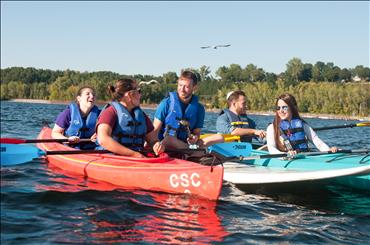All oars in the water

Photos by Jamie Goldberg
When it came time for Jewish University of Vermont students to perform tashlich this year, the Hillel told them to go jump in a lake.
All kidding aside, UVM Hillel put a remarkable spin on the spiritual practice of casting one’s sins into a body of water by hosting its fifth annual Kayak Tashlich on Lake Champlain.
Students paddled out into the lake on kayaks with bread crumbs to throw in the water, symbolic of throwing away one’s sins of the past year and starting the new year with a clean slate. Traditionally, this ritual is held at a time between Rosh Hashanah and Yom Kippur, because participants hope to start the new year fresh.
Assistant Director Sharon Silverman said this campus Hillel tradition started after a push from students for more Jewish outdoor programs.
“This entire idea came from giving students the space to voice their needs and then supporting those voices with action,” Silverman said. “We continually give students the space to lend their voices and ideas of what Jewish life can and should be at the University of Vermont.”
Oraya Zinder ’18 said Kayak Tashlich is a good way for Hillel to make personal connections to Jewish students on the periphery of Jewish life, because high holidays are a time that might bring students who don’t attend other events.
“[Kayak Tashlich] has many benefits for the University of Vermont Hillel, because it’s an event that makes students want to be more engaged and involved, which is always a good thing,” Zinder said.
While Kayak Tashlich is a Hillel initiative, the program has grown to include graduate students, alumni and community members of Burlington.
All around the globe, Hillels excel at finding creative ways to blend local culture with Jewish traditions.
Hillel of Northern Nevada has had a Jewish Hiking Club in previous years, and students have also organized hikes in the Sierra Nevada mountain range on Shabbat. Atty Garfinkel, executive director of Hillel of Northern Nevada, said these outdoor activities are especially Jewish because they are a way to reveal the “splendor of creation.”
According to Garfinkel, residents of Northern Nevada view nature as much of a sanctuary as any synagogue, a place to be in the presence of the creator.
“Within Judaism we have prayers that we say upon seeing a natural wonder, on seeing a rainbow, or a spectacular view. When standing on top of the Sierra mountains looking west to California or east to Nevada, who would not be inspired to at least express gratitude and say [a prayer]?” Garfinkel said.
–Paige Gutter